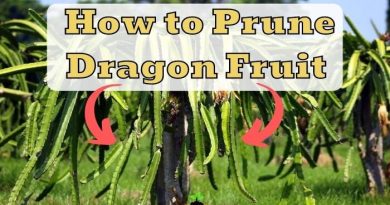Why Are My Kalanchoe Leaves Soft? (6 Surprising Reasons)
Kalanchoe green and fleshy leaves are their main characteristic and attraction. If we see a kalanchoe with soft leaves, not only will its appearance look bad or damaged, but it also shows that it has a deeper problem. If you want to know why your kalanchoe has soft leaves, you’ve come to the right article.
The main reason always lies in improper watering. Usually the plant is underwatered or overwatered, and for this reason the leaves become lethargic, the flower stalks droop, dark hard or soft spots appear on the leaves. Some other reasons why your kalanchoe leaves are becoming soft include: too much sunlight exposure, fungal diseases and excess use of fertilizers.
| Why Are My Kalanchoe Leaves Soft |
|---|
| 1. Too Much Exposure To Intense Sunlight |
| 2. Improper Soil And Poor Drainage |
| 3. Overwatering (Excess of water) |
| 4. Underwatering (Lack of water) |
| 5. Overfertilization |
| 6. Diseases |
1. Too Much Exposure To Intense Sunlight
Kalanchoe is a plant that is sensitive to direct sunlight. The leaves can become soft and wilted when the plant is overly exposed to sunshine. This occurs due to bright sunshine causing the plant to lose water during transpiration quicker than it can absorb moisture through its roots.
Unfortunately, the harm is irreversible. The injured leaves cannot hold water and lose their ability to photosynthesize, making the leaves soft.
Sunburned Kalanchoes have soft and brown discoloration of the leaves due to tissue death.
Kalanchoes prefer to thrive in direct sunshine, but that doesn’t imply they can withstand the sun’s extreme heat. Kalanchoes need full sun for most of the day but also demand moderate shade. Your plants will be scorched if they are exposed to more sunlight than they can tolerate.
Also, ultraviolet (UV) rays can damage kalanchoe leaves, disrupting the photosynthetic process on which the succulent relies to make energy. This can cause the plant to become stressed and weak, resulting in leaf softening.
Treatment
Scorching in direct sunlight should be avoided. When the weather is too hot, bring your plants indoors.
To avoid this, giving Kalanchoe plants the proper quantity of sunshine for their individual needs is critical. They should be kept in an area that receives bright, indirect sunlight and should not be exposed to direct sunlight for extended periods.
If the leaves have gotten soft, transfer the plant to a shadier position and thoroughly water it to help it recover.
2. Improper Soil And Poor Drainage
Kalanchoe leaves can grow soft due to poor soil and drainage, leading to overwatering and root rot.
Kalanchoe plant needs well-draining soil and cannot be left in water over long periods. Planting them in poorly draining soil makes it harder for them to develop healthily. Less sandy and clayey soils typically contain more water and less air, making it difficult for Kalanchoes to breathe adequately.
When the soil does not drain properly, depriving the roots of oxygen and leading them to rot. As a result, the plant may struggle to absorb water and nutrients, resulting in wilting and soft, limp leaves.
Also, soil that is not suitable for Kalanchoe can produce issues. For example, overly deep or compacted soil may prevent proper water drainage, resulting in the same problems as root rot and mushy leaves.
Treatment
To avoid these issues, ensure the soil is well-drained and suitable for Kalanchoe plants. It is also critical to avoid overwatering and provide appropriate drainage so that excess water can escape from the soil.
Use well-draining soil of 60% peat moss and 40% perlite. You can make your own soil or buy a ready-made succulent mix from the store. Incorporating pumice will also help your soil drain more quickly.
3. Overwatering (Excess of water)
Overwatering can end up causing kalanchoe leaves to grow mushy for a variety of reasons.
When kalanchoe receives excess water or humidity, it may present the following symptoms:
- Very soft or “watery” leaves.
- Leaves yellowish or slightly translucent.
Kalanchoes prefer moderate watering and despise being overwatered. Overwatered Kalanchoe plants absorb a lot of water, and their leaves and stems swell and eventually rupture. These plants dislike a lot of water, love, and attention.
Overwatering damages the roots of kalanchoe plants, causing the leaves to weaken and lose their turgidity. This is due to the roots’ role in absorbing and transporting water and nutrients from the soil to the rest of the plant. If the roots are destroyed, the plant will be unable to feed itself, and it will begin to wilt and display other signs of distress.
Overwatering can cause root damage and the development of fungi and bacteria in the ground, which can attack kalanchoe and cause its leaves to become mushy and discolored.
Overwatering can also cause root rot in some situations, which can be challenging to treat and may eventually lead to the plant’s death.
Overwatered kalanchoes have soft, mushy leaves. In certain situations, the hue of the leaves will become lighter than usual green or even translucent. You will also notice leaf shedding even with a light touch of your hand or fingers.
Fortunately, you can save your overwatered Kalanchoe plants with correct care in the early stages. Keep an eye out for symptoms of overwatering. Stop watering as soon as the indications arise and allow the soil to drain and dry properly before watering again.
Treatment
- If there are a few damaged leaves, it is enough to properly prune the leaves and reduce irrigation.
- If the plant presents continuous flooding, it will also be necessary to change the substrate or pot for one with better drainage to avoid excess water at the root.
- In very serious cases, the water rots the roots, and kalanchoe must be transplanted and all the rotten roots must be cut out.
The roots of an overwatered Kalanchoe will rot and perish while the leaves will become too soft. Because some sections of the plants are still living, they are easier to salvage in the early stages. You can propagate an utterly new plant by removing a leaf or a tiny stem (just the living components, not the dead ones).
To avoid overwatering a kalanchoe plant, water it only when the soil is dry to the touch and only water it occasionally. Using well-draining soil and keeping the plant out of water is also a good idea. Following these suggestions, you can keep your kalanchoe plant healthy and vibrant.
4. Underwatering (Lack of water)
Kalanchoe plants need to be watered regularly to maintain good growth and foliage. When a kalanchoe plant is not adequately hydrated, it might experience under watering, which causes the leaves to become soft and drooping.
Kalanchoe’s thick stems and leaves conserve water and to a degree they can tolerate periods of drought. However, this does not imply that they do not require any water.
As the kalanchoe first draws the water it needs to survive from the water stores stored in the foliage, the volume of the water cells there decreases. The result: the succulent leaves become soft and hang limp.
The leaves will lose their turgor pressure, giving them a stiff and upright appearance. The leaves get softer and more pliable as they lose moisture and may even wilt or droop.
Underwatering can induce various symptoms in kalanchoe plants, such as yellowing, browning, or curling of the leaves, in addition to soft leaves. The plant may drop its leaves or stop growing entirely in severe circumstances.
Treatment
Kalanchoes require a constant water supply and will begin to show signs of under watering if they become exhausted.
How to solve the problem:
- Check whether the substrate has actually dried out
- Place the kalanchoe in bone-dry soil in soft water until no more air bubbles rise
- Alternatively, repot in fresh soil and water properly from now on
- From April to September, kalanchoe needs to be watered regularly.
- Only during the winter dormancy is the water supply reduced to a minimum.
To keep kalanchoe plants healthy and prevent under watering, water them often and thoroughly, ensuring the soil is equally moist but not waterlogged.
It is also critical to keep the soil dry between watering sessions. Kalanchoe plants may produce beautiful, robust foliage with proper care and attention.
The plants will usually perk up after proper watering. Be careful not to overwater your Kalanchoes while attempting to return your plants to normal as quickly as possible.
Provide them with one or two regular irrigations, and the plant will resume average growth. Hold on tight! Wait for the soil to dry thoroughly before watering again.
5. Overfertilization
Overfertilization is a prevalent issue that can harm the health of various plants, including Kalanchoe.
Kalanchoe plants are popular houseplants that are very easy to care for, yet, they can be sensitive to environmental changes, particularly the amount of fertilizer they receive.
Overfertilization of kalanchoe plants can cause the leaves to become soft and fragile. This is because an accumulation of fertilizer can generate excess salt in the soil, causing the plant to absorb too much water.
This can cause “edema,” in which plant cells fill with water and swell, making the leaves mushy and spongy.
Overfertilization and generating mushy leaves can cause root damage, slowed growth, and even death in kalanchoe plants. If you notice tiny brown stains on the foliage of your Kalanchoe plants or the leaves becoming soft, you may be overfertilizing them.
Treatment
To avoid overfertilization, follow the prescribed fertilization instructions for kalanchoe plants, which generally involve using a balanced, water-soluble fertilizer at half the recommended concentration every 2-4 weeks during the growing season.
It is also critical to carefully water the plant before and after fertilizing to help remove excess salt from the soil.
Apply a good dose of fertilizer in the spring and summer if you have a balanced fertilizer. You can also nurture your plants once a month with a modest amount of fertilizer. Should not fertilize your Kalanchoes in the winter or late fall since the plants need to rest.
6. Diseases
If your kalanchoe leaves are becoming soft and falling, it could signify a fungal or bacterial infection. Thielaviopsis root rot, often known as black root rot, is a fungal infection that results in badly damaged roots and reduced plant growth.
Kalanchoe that has been infected may have a black stem or even a black longitudinal fracture in the stem. According to the University of California Statewide Integrated Pest Management Program, the disease is more likely to strike under damp conditions and cool temperatures ranging from 55 to 61 degrees Fahrenheit.
Although benzimidazole fungicides are an excellent soil treatment option, it is preferable to eliminate decayed plant material if your kalanchoe has seriously rotted roots and soft leaves.
Overwatering and fertilization can make the plant vulnerable to this virus. When a plant becomes sick, it is better to remove the diseased kalanchoe.
Bacterial soft rot, caused by the bacterium Erwinia carotovora, is another infection that can lead Kalanchoe leaves to become soft. This disease can cause the leaves to become soft and slimy, with a horrible odor. The bacteria can enter the plant through wounds or cuts and quickly spread throughout.
Powdery mildew, a fungus, can also harm kalanchoe. This ailment is distinguished by powdery grey or white growth on the plant’s surfaces. The ailment is usually not dangerous and is easily treated. Keep the plant’s foliage fresh and avoid putting it in a humid, chilly, or drafty environment. Place the plant in an area where it will receive more sunshine.
Viral infections can also harm Kalanchoe plants, causing the leaves to soften and distort. The Kalanchoe mosaic virus, for example, can develop yellow or green patches on the leaves and make them feel soft and spongy. This virus can be transmitted by insects or contaminated tools or soil.
In conclusion, stem rot, bacterial soft rot, and viral infections can all cause Kalanchoe leaves to become soft. Diagnosing and treating these illnesses as soon as possible is critical to prevent them from spreading and causing further damage to the plant.
How to prevent Kalanchoe leaves from becoming soft
As a gardener, I prepared you some ways to prevent soft leaves on your Kalanchoe:
- Water Properly: Kalanchoes are succulent plants that store water in their leaves, so they do not need to be watered frequently. Overwatering can lead to soft leaves, root rot, and other issues. Water your Kalanchoe only when the soil is completely dry, and be sure to provide adequate drainage to prevent water from pooling around the roots.
- Provide Proper Lighting: Kalanchoes need bright but indirect light to thrive. If they are kept in low light conditions, their leaves can become soft and stretched out. Keep your Kalanchoe in a spot that receives bright, indirect sunlight for at least a few hours each day.
- Fertilize accordingly to Requirements: While Kalanchoes do benefit from occasional fertilization, too much fertilizer can lead to soft, weak growth. Use a balanced, water-soluble fertilizer once a month during the growing season, and reduce or stop fertilization during the winter months when the plant is dormant.
- Check for Pests: Mealybugs, spider mites, and other pests can damage Kalanchoe leaves and cause them to become soft and discolored. Check your plant regularly for signs of infestation, such as webbing, sticky residue, or tiny insects, and treat promptly with an insecticidal soap or neem oil.
- Prune as Needed: Pruning can help encourage strong, healthy growth and prevent soft leaves. Remove any dead, damaged, or diseased leaves or stems, and trim back leggy growth to promote bushier growth.
Frequently Asked Questions
You should change the pot with new soil for succulents , without watering for at least 15 days, put the pot in full light and you will see that the plants will recover as temperatures rise.
To ensure healthy and constant growth for your succulents, we recommend using specific fertilizer for cacti and succulents.
When the succulent has finished flowering, you can stimulate flowering again by darkening .
If you don’t do this, the plant will flower naturally in the spring. The Kalanchoe not only does well as a houseplant, but can also be used outside as a terrace or balcony plant when the night frost is over.
1.Dry the soaked roots.
2. Transplant to a dry substrate to prevent rot development.
3. Treat the soil with a fungicide.
4. Add water or humidify the air if the reason for the death
of Kalanchoe was this.
5.Move to a suitable location if the temperature and lighting are not suitable.
Almost any corner in the house is suitable for Kalanchoe , where at least a little sunlight gets . It grows well in both partial shade and diffused sunlight.
If you put it where direct sunlight falls, then the flower will only slightly change the color of the leaves (they will turn slightly red).




